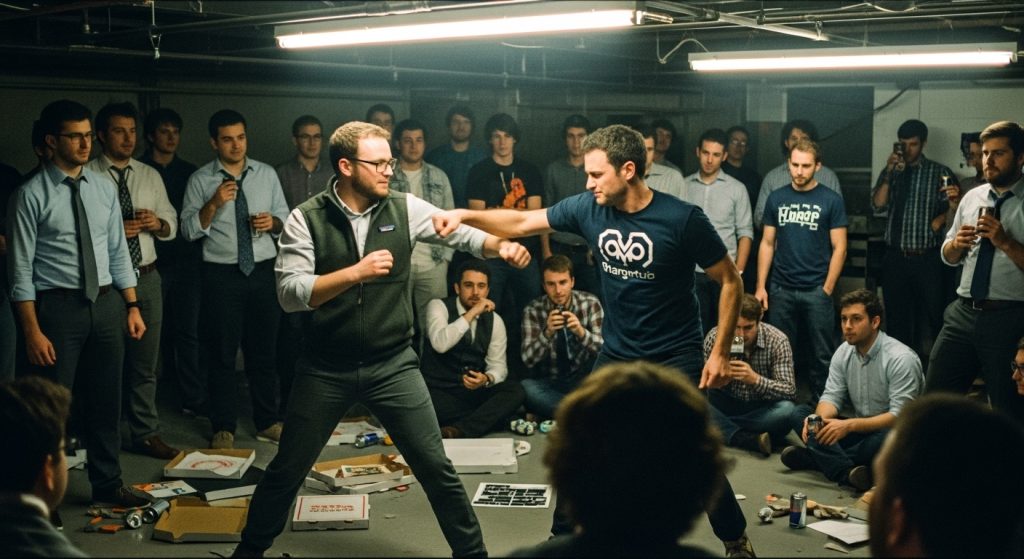The first punch hit like a sledgehammer—a bare-knuckled jab that snapped my head back and sent a jolt of pain radiating through my jaw. My vision blurred, the basement’s dim lights streaking into hazy lines. My opponent, a lean guy with a buzzcut and a faded tattoo coiling up his arm, didn’t flinch. He swung again, a wild hook I ducked by instinct alone. Sweat stung my eyes, and the air hung heavy with the stink of damp concrete, cheap beer, and raw adrenaline. This wasn’t a sanctioned boxing match or a padded MMA gym. This was an underground fight club—gritty, illegal, and unfiltered—and I’d gone in deep to uncover what draws men to these hidden rings in 2025.
The concept isn’t new. Chuck Palahniuk’s 1996 novel Fight Club and David Fincher’s 1999 film birthed a cultural mythos, but real-life versions have existed for decades, from Silicon Valley tech bros scrapping in garages to New York punks brawling in alleys. They’re outlawed in most places, shrouded in secrecy, and fueled by a volatile brew of testosterone, frustration, and a quest for something visceral. As a journalist, I wanted to decode it: Who steps into these circles? Who risks arrest to run them? What keeps this subculture alive? To find out, I went undercover, immersing myself in a world where the first rule—don’t talk about fight club—is more a wink than a wall.

The Hunt for the Ring
Entry took legwork. Underground fight clubs don’t flash neon signs or trend on X. They spread through murmurs, coded messages, and guarded trust. My inroad was a guy I’ll call Mike, a 32-year-old mechanic I met at a dive bar in a midsized U.S. city. (Names and places are obscured for legal and safety reasons.) Mike had rough hands and a cagey air, the kind of guy who’d seen more than he said. Over beers, I nudged the conversation toward weekend plans. He dropped a hint—“a thing some guys do” near the industrial sprawl—and after some coaxing, slid me a time and a vague address: a derelict warehouse on the city’s edge.
I arrived under a moonless sky, pulling into a lot dotted with a dozen cars, headlights off. The warehouse loomed—cracked windows, rusted siding, a chain-link fence sagging into the dirt. A broad-shouldered guy in a hoodie guarded the door, checking names off a crumpled notepad with a flashlight. I gave Mike’s name, handed over a $20 “donation,” and stepped inside. The space was cavernous, lit by flickering work lamps strung from rafters. About 50 men, mostly 20s to 30s, clustered around a makeshift ring: a square of scarred concrete edged with duct tape and frayed ropes. The air crackled with tension, anticipation, and the clatter of cans.
Real-world parallels abound. A 2015 Daily Mail report documented New York’s underground scene, where “models, marines, and hipsters” fought in secret venues like Brooklyn basements. In Bangkok, a 2022 US Sun article detailed a street fight club launched by a 30-year-old tired of Muay Thai’s rules, drawing dozens to scrap in alleys. My night echoed those: no glitz, just grit.
The Bare Rules
Before I fought, I watched. A stocky organizer, Tony, a 38-year-old ex-boxer with a gravelly bark, laid out the ground rules: no biting, no eye gouging, no weapons. Beyond that, anything went—fists, kicks, elbows, knees. Fights ended when someone tapped, passed out, or couldn’t rise. No rounds, no gloves, no refs. It was primal, a far cry from the regulated elegance of pro boxing or MMA.
The opening bout pitted a wiry construction worker against a thick-necked bouncer. The construction guy moved fast, peppering jabs, but the bouncer absorbed them like a slab of granite, then floored him with a meaty forearm. Blood spattered the concrete—bright red under the yellow glow—and the crowd roared, some cheering, others jeering as the loser limped off, nose dripping. No medics swooped in; the winner just cracked a beer from a bystander. It was raw, chaotic, and unscripted.
A 2008 HowStuffWorks piece described real fight clubs as “outlets for men and women” seeking visceral release, often spread by word of mouth or cryptic online posts. That matched here: these weren’t trained fighters. They were welders, bartenders, students—ordinary guys with day jobs and restless spirits. A 2023 Vice article on Manchester’s King of the Ring club noted a similar crowd—manual laborers and desk jockeys alike—drawn to bare-knuckle nights for reasons ranging from boredom to bravado.
My Turn in the Ring
I hadn’t meant to fight. The plan was to observe, catalog details, and fade out. But Tony clocked me as fresh meat. “New guy,” he said, his squint half-suspicious, half-amused. “You watch, you fight. That’s how it goes.” The crowd’s eyes locked on me, a silent dare. Backing out risked blowing my cover—or worse, getting shut out. So, I nodded, shed my jacket, and stepped onto the concrete, its chill seeping through my soles.
My opponent was the buzzcut guy—Chris, I’d learn—a 27-year-old warehouse worker with a lean frame and a restless bounce. He gave a curt nod, no words, just a roll of his shoulders. I’d boxed enough to know the basics: guard up, feet light, don’t freeze. But this wasn’t a ring with mats and a bell. The crowd’s shouts drowned my focus, and when Tony yelled “Go!”, Chris charged.
That first punch rattled my skull, but adrenaline kicked in hard. I ducked his next swing—a sloppy haymaker—and landed a shaky jab to his chest. He grunted, then slammed an elbow into my ribs, a thud that stole my breath. Pain flared, but I kept moving, circling, throwing punches when openings appeared. It was less a fight than a scrabble—messy, frantic—but after two minutes, I caught him with a wild hook to the jaw. He stumbled, raised a hand, and croaked, “Done.” The crowd clapped, a muted acknowledgment. Tony thumped my shoulder: “Solid, rookie.”
I walked off with a bruised rib, a split lip, and a buzzing head, but I’d earned a foothold. Chris shook my hand later, no grudge, and shared a beer. “It’s not about winning,” he said, voice low. “It’s about feeling alive.” He’d been at it a year, he added—warehouse shifts left him numb, and this was his antidote.
Who They Are, Why They Fight
Chris’s words lingered. Why do this—risk injury, arrest, shame—for a few minutes of chaos? The fighters I met offered clues. Jake, a 34-year-old welder with a chipped tooth, said it beat “scrolling TikTok all night.” Sam, a 23-year-old dropout, craved “something to prove” after flunking college. Tony, the organizer, started it three years ago post-divorce, a former amateur boxer turned truck driver needing an outlet. “Some guys are just mad—at life, at everything,” he said. “This is cheaper than therapy
Documented cases flesh this out. A 2005 NPR report on Silicon Valley fight clubs described tech workers brawling in garages, a release from cubicle monotony. A 2019 New Yorker piece, “The Men Who Still Love ‘Fight Club,’” profiled a range of devotees—some lost, some angry—drawn to the film’s ethos. In London, a 2016 Guardian article uncovered a “Gentlemen’s Fight Club,” where white-collar types swapped suits for bare fists, chasing a rush absent from their 9-to-5s. Bangkok’s 2022 scene, per US Sun, pulled in young men bored by traditional martial arts, craving freer violence.
Psychologists weigh in too. A 2020 RTD feature cited experts tying fight clubs to a primal urge for physicality in a digital age. Dr. Michael Kimmel, in his book Manhood in America, argues modern masculinity lacks clear markers—tests of grit or endurance. Fight clubs, however crude, might fill that void. A 2011 Psychology Today piece suggested they’re “cathartic” for some, a way to purge pent-up aggression without guns or gangs.
The Fight Club legacy looms large. Palahniuk invented it, but reality followed. A 2009 Complex article documented copycats—like a teen bombing a Starbucks, inspired by Tyler Durden’s Project Mayhem. A 2024 Atlantic essay called the film’s critique “apt” for today’s polarized, screen-addicted world. Here, though, it’s less ideology, more instinct. Tony scoffed at grand theories: “We’re not blowing shit up. Just scrapping.”
The Stakes and Scars
The toll is steep. Bare-knuckle fighting skips gloves, hiking the odds of cuts, fractures, and concussions. A 2018 BBC report on UK underground bouts noted fighters shrugging off broken hands; Vice’s 2023 Manchester piece described a DIY medic stitching gashes with fishing line. Here, a battered first-aid kit sat in the corner, manned by a guy who’d rather crack jokes than sutures. When a fighter dislocated a shoulder, they popped it back with a yelp and a curse—no hospital run.
Legally, it’s dicey. In the U.S., unsanctioned fights violate athletic commission laws, risking fines or jail. The 2005 NPR piece said Silicon Valley cops often ignored discreet clubs, but a 2017 LA Times bust of an LA fight ring netted arrests. Tony downplayed it: “Cops got bigger fish.” Still, the club shifts spots—warehouses, barns, garages—staying off radar with no digital footprint, just texts and whispers.
Socially, it’s divisive. Critics, per the 2019 New Yorker, slam fight clubs as toxic masculinity run amok; fans call them a reclaiming of agency. I saw both: raw aggression, yes, but also a rough bond. Post-fight, strangers offered me water, a nod, a “nice one.” It wasn’t warm fuzzies, but it was real—a fleeting pack formed in the fray.
The Wider Lens
Stepping back, is this a sign of something broader? The Atlantic’s 2024 take tied Fight Club’s resonance to Trump-era rage and the “manosphere”—online echo chambers of male grievance. Earlier, the 2005 NPR piece linked it to post-9/11 angst; Palahniuk pegged it to Gen X drift. In 2025, with AI displacing jobs and screens dominating life, it might reflect men unmoored—seeking stakes in a world gone soft.

I dug deeper with the crew. Jake showed me a scar from a fight gone wrong—two teeth out, no regrets. “Work’s a slog,” he said. “This is alive.” Sam, post-bout, wiped blood from his chin and grinned: “Here, I’m not a failure.” Tony, chain-smoking outside, traced his path: teen boxer, pro dreams, then life—bills, a kid, a busted marriage. “This is my ring now,” he said. “Keeps me going.”
The crowd was a mosaic: a grizzled biker, a scrawny kid barely 20, a guy in a faded polo who might’ve been a clerk. No cliques, just a shared hunger. Between fights, they traded tips—ice a swollen fist, dodge late-night patrols—pragmatic, not preachy. It was a subculture of doers, not talkers.
The Night Fades
By 1:30 a.m., the buzz faded. The final fight ended with a guy tapping after a knee to the ribs, and the crowd trickled out—some to cars, some to the street. My ribs ached, my lip throbbed, but I’d seen it clear. Tony’s crew would regroup soon, a new spot texted last-minute. Chris would return—“Always do,” he said. “It’s where I’m not numb.” Jake flexed a bruised hand, nodding. Sam just smiled, blood crusting his jaw.
I left, ears ringing, replaying it. These aren’t Fight Club’s anarchists—no soap bombs or manifestos. They’re regular guys—lost, pissed, or wired—chasing a pulse in a flatline world. Tony keeps it rolling, dodging trouble one night at a time. For them, it’s not the punches you throw, but why you take them—a shot at feeling something, scars and all.
Me? One night was enough. I got it: this isn’t chaos for kicks. It’s a lifeline, a gauntlet, a howl against a life too tame. In 2025, for these men, that’s worth the blood on the floor.





